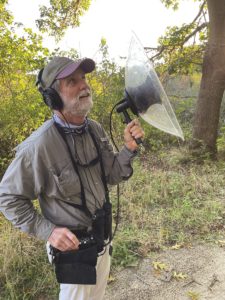WELLFLEET — Tom Marvel begins his birding excursions around 6 a.m. most days. He’s running late on this particular Wednesday, and the sun has risen by the time he sets out along High Toss Road. A recording device with adjustable volume is harnessed to his waist, linked by one cord to a pair of headphones that rests around his neck and by another to a microphone he wields gracefully despite its being four times the size of his head.
This latter piece of equipment is Marvel’s distinguishing feature as a birder of the Outer Cape, where he estimates that there are 20 birders who are visually oriented — equipped with a camera and/or binoculars — for every one auditory birder in pursuit of bird sounds. Marvel’s microphone is a parabola, and at the center of the bowl is the recording device itself. The parabolic shape harnesses incoming soundwaves, directing them to the focal point at the base of the arc where the microphone is mounted. It amalgamates sound the way a satellite dish does energy. Drawing the bird calls to a point, it amplifies and clarifies them.

Birding has made Marvel more attuned to ambient noise as well as bird calls. Until you listen this way, “You don’t realize how much noise there is in the background,” he says, as a school bus, not yet in view, beeps down the road. This morning’s recordings, all taken alongside the marshy Herring River basin, are punctuated by wind, faraway cars, and barking dogs.
Marvel has been a birder for eight years. During that time, he’s learned to recognize the calls and songs of most birds common to the Outer Cape, where he spends two summer-to-autumn months each year, and of those heard in Naples, Fla., where he lives the rest of the year. In Eastham, he’s a birder. In Naples, he works as a commercial fisherman.
To bird is “to be aware of birds and able to identify them correctly — whether it’s as you sip your coffee in the morning or as you travel the world,” says Marvel. He says birding is akin to dating: “There is a huge range in how people go about it.” If you’re going to bird with someone else, it’s important that you “get along and have the same style.”
Marvel stops periodically. “Did you hear that?” he asks. “That’s a hairy woodpecker.” He puts on his headphones, holds his microphone up, and rotates slowly left and right until the call is at peak volume. Often, he uses the app Merlin, developed by the Cornell Lab of Ornithology, to confirm that he’s identified the bird correctly. His abiding humility as a birder is punctuated by glimmers of satisfaction that show through when his species speculations are sanctioned by technology.
Marvel stands enraptured and listening for minutes. It’s a rare moment when several species are both visible and audible, flitting from one branch to another, popping out from between two leaves.
Nestled within the sound of the breeze through the trees were the calls of a downy woodpecker, a gray catbird (two different calls), an Eastern towhee, and a tufted titmouse. The distinctions were mostly imperceptible to a nonbirder’s ear. There was also a Carolina wren, a pine warbler, and a red-breasted nuthatch. And the first indigo bunting Marvel had come across on Cape Cod this year.
When he gets home, Marvel uploads the recordings from the parabolic microphone’s SD card. Then, with an assist from the eBird website, he makes sonograms of the noises. Some species make 10 or 12 different sounds, and Marvel says it “can be hard to dial into them all.” The sonograms help not just with identifying the species at hand but also with categorizing a particular call. By the end of that day’s walk, according to eBird, Marvel has recorded the sounds of 39 different species.
Cornell’s eBird website is not just user-friendly, it is user-dependent. Marvel received an email at the end of last year letting him know that the site had added 49 of his recordings to its species identification directory.
Because of the southward fall migration that’s underway, a number of species now on the Outer Cape are making brief local appearances. Marvel points out two: a Wilson’s warbler and a dark-eyed junco.
Because of fallout, which according to eBird occurs “when a good migratory movement of birds encounters rain, low overcast, or foggy conditions” and the birds subsequently land together for a spell, this morning preceding Hurricane Ian’s arrival in the South offers high bird density. As Marvel puts it, “the weather bunched them up. The trees are dripping with them.”
A recording of a hairy woodpecker made during this walk with Tom Marvel.
